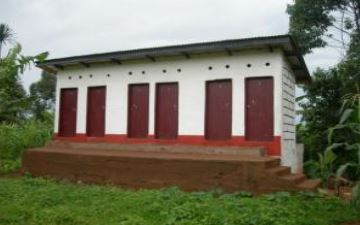1) What is involved ?
These latrines, which are sometimes also called green latrines, biolitter latrines, Arborloo single-pit latrines or Fossa alterna twin-pit latrines are ecological, low-cost latrines that, by treating excreta in a simple, natural way, allow compost to be produced, in other words, nutrient-rich soil for agriculture.
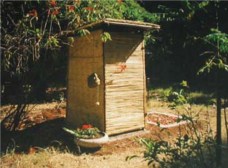
Twin-pit latrine with a lightweight, moveable structure - Photo CREPA
2) Who use or recommends this means and since when ?
Primarily rural or mountain dwellers and sometimes dwellers of suburban areas, especially where there are opportunities for selling compost. This type of use is, however, relatively recent in developing countries where it is, however, developing fairly quickly.
3) Why ?
Because it’s is a simple means, when only limited resources are available, of preventing pollution and health risks associated with poor sanitation while transforming embarrassing waste into valuable agricultural resources through simple biological processes.
What is generally regarded as embarrassing, hazardous waste can, through this process, become a valuable resource and replace expensive and sometimes fertilizers.
4) What does this type of latrine involve ? What process is used ?
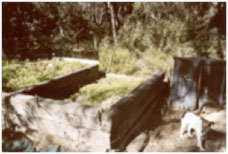
Material composting bins in a garden. Photo by WEDC
This latrine is built on the same principles as the single- or twin-pit latrine, whether ventilated or otherwise, and only differs from them in that at each use plant material or ash is added to excreta, which are collected in pits or rather in compartments as they are easier to empty and shallower than pits.
This gives rise to natural composting, which is an aerobic process in which bacteria and other organisms feed on organic materials discharged with faeces and break them down and make them safe by destroying pathogens over a period of at least a year, and which can then be used as fertilizer by adding other biodegradable materials such as household organic materials.
The compost obtained is a fertilizer rich in organic matter (phosphorus and potassium) that improves soil quality through its humus structure.
They are simple to use.
After each visit to the toilet, except when used only for urination, users are themselves involved in this compost transformation by adding a small amount of crushed dry plant (sawdust, dead leaves, wood shavings, chopped straw, etc. or earth (no more than 5 to 10%) and wood ash (no more than 10%), which also has the advantage of greatly reducing unpleasant smells and flies.
It should be noted that if urine and faeces are separated as well, you then obtain the most environmentally friendly and efficient type of latrine, usually known as ECOSAN (see Fact sheet A10 "ECOSAN environmentally-friendly latrines").
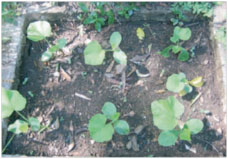
Food crops
This process makes the latrine cost efficient by using its natural byproduct, compost.
This is :
- either used as fertilizer after a period of 6 months to a year, after which time it becomes free of pathogens
- or used to plant fruit or ornamental trees (there are many examples of successful planting including mango, banana, guava, avocado, papaya, etc.) in the former location of the pits, or elsewhere,
- or used as a fertilizer additive for various plantations including vegetables (for instance, pumpkin, tomato and passion fruit crops), while avoiding, as a simple precaution or to avoid psychological rejection..., growing vegetables or salads in direct contact with the compost.
For these crops, soil and compost can be mixed in equal proportions or as one part compost for 2 parts soil. But it is also recommended to mix this compost with compost from other sources and add leaves or composted garden waste, if available.
5) What are the main types of compositing latrines ?

Compartment latrine. Photo by CREPA

Manufacturing of a slab and a compartment. Photo by CREPA
There are essentially four types : single-pit or single-compartment latrines (for example, Arborloo), twin-pit or twin-compartment latrines (often called Fossa alterna), bucket latrines (or biolitter latrines) and rarer continuous composting latrines.
Compartment latrines differ from other types in that they are not buried, or only shallowly buried, which is more convenient for emptying them and using the sun’s heat to activate the compost, although this makes them slightly more expensive.
a) Single-pit simple composting latrines (Arborloo type)

Functional diagram of a twin-pit composting latrine (WEDC) 
Like other latrines, they have 4 items : a pit and a base to protect this pit and support the slab, a concrete slab and a superstructure or stall.
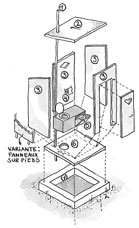
Drawing for building an
Arborloo pit. Jacques Morel 
Construction,
- first make a round or rectangular concrete slab, (for example, with a diameter of 1.15 m for a 1 metre pit) making, for example a mould consisting of a ring of bricks at the bottom which may be lined with a plastic sheet and on which are placed, to make the squat hole, either bricks or stones, or simply a plastic bucket distorted at the base (which can also be encased in concrete later to provide a seat)
- then make a base to support the slab and prevent the pit collapsing if the ground is somewhat soft. It can be made of concrete, lightly reinforced by an iron framework, or using the bricks that were used to make the mould and between which the concrete is poured,
The base around which the compacted earth is placed also allows rainwater to be diverted from the latrine.
To avoid flooding during heavy rains, it may be located on a small rise of land.
If the ground is too soft, a base will, however, not be sufficient and the pit must then be consolidated
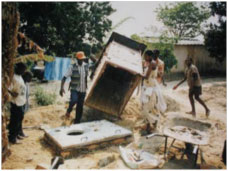
Installing or transferring a lightweight superstructure
Photo by CREPA
- dig the pit inside the base once positioned at a depth of 1 to 2 m according to the desired capacity,
- dig the pit inside the base,
- position the slab on the base,
- build the latrine superstructure or stall using all kinds of materials, the easiest and cheapest being to use wooden poles and grass or straw, but if possible with a lightweight door and roof and making it functional and attractive, for example, by providing at least a rudimentary seat that can be made on the spot,
- install a washbasin near the latrine (this can be very simply made by piercing a plastic water bottle, filling it with water and screwing on its cap : then just unscrew the cap to get a trickle of water with a bar of soap being placed nearby.
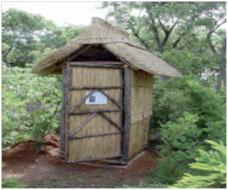
Simple removable structure Photo by CREPA
Instructions for use
Before use, a layer of leaves about 20 cm thick must be placed in the bottom of the pit.
At each use (except for urine), then add a good cup of crushed dry plant or soil and ash (see above), which speeds up the composting and reduces flies and unpleasant smells.
Anal cleansing should wherever possible be carried out without water or with as little water as possible, and preferably using dry materials (leaves, sawdust, paper) instead.
When the pit is almost full, remove the superstructure, remove the base and the slab, cover the pit with a thick layer of soil (15 to 20 cm), choose a new location, install the base on it and surround it with compacted earth, dig the pit, pour a bag of leaves into it, and previously removed pit slab and superstructure.
b) Twin-pit (or twin-compartment) composting latrines (Arborloo type) : Fossa alternata
These latrines differ from the previous ones in the construction of two permanent shallow pits (about 1.5 m deep) close to each another, thereby allowing the construction of a common superstructure sheltering them permanently so as not to have to remove them as in the previous case. A less expensive lightweight superstructure that can be moved from one pit to the other may, however, be built but this is much less convenient.

Functional diagram of the Fossa alterna.
Situation after one year. (WEDC) 
Each pit is used alternatively. When the first pit (pit 1) is full, it is closed and covered with a layer of soil, and the second pit is then used by moving the superstructure, if it was designed for only one pit.
The contents of the 1st pit should be left to stand for a year, the time required to obtain compost free of pathogens.
When pits are filled faster (due to being shallower or used by a larger family), they can be emptied every 6 to 9 months so as to use the compost with precaution elsewhere (for planting trees, for example), but not using it for a vegetable garden.
Such latrines last many years. The regular addition of soil, wood ash and leaves speeds up the composting process.
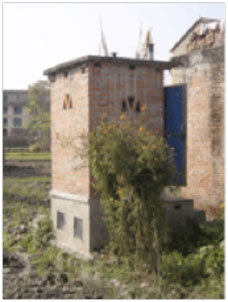
Latrine with two raised pits
Photo by WELL
Construction and precautions to be taken
Their construction is similar to that of single-pit latrines
- As in the previous case, plastic, glass, cloths and trash should not be thrown into the pit and a hand washing system should be added.
- Preferably dig rectangular pits (most of them are dug this way), which are easier especially for producing the mould of the superstructure (wood is sufficient) and slabs.
- Provide a minimum distance of 50 cm between the two bases with a thickness of about 7 to 10cm.
c) The compost bucket latrines (biocontrolled bedding latrines)
These latrines which are easier to build and cheaper differ from the ones above by the pits being replaced by simple buckets. While their advantage is their simplicity and the fact that they can be built in urban areas, or even inside a house if ventilation is added, they have the drawback of being more restrictive to manage.
Principle : users relieve themselves in a stall located above a bucket which is emptied when full
on a small composting platform or which is discharged. The container’s capacity depends on the number of users (15 to 40 litres).
|  |
  |
Construction :
Is extremely simple since limited to the construction of the seat with an opening lid inside which the bucket is placed and the building of a lightweight external superstructure or ventilated internal stall.
Precautions to be taken :
- the bucket must be emptied frequently (1 to 3 days) on a small composting platform provided in the garden and filled with ten cm of crushed straw or leaves before re-use.
- excrement must be composted for at least 1 to 2 years to ensure they do not contain pathogens any longer.
- it may be more convenient to have a composting platform consisting of three bins measuring about 1 m3. The first bin can then be filled during the first year. And the second bin filled the second year. At the end of the 3rd year (or during the 3 rd year if there doesn’t seem to be any need to wait for two years, even although this is recommended), the compost of the 1st bin and so on.

Diagrams by CREPA 
d) Continuous composting latrines
Unlike the previous model, these latrines are much more sophisticated and more expensive and will only be mentioned here for reference.
What does this process involve ?
The excreta fall from a toilet. Organic waste from the kitchen and garden are thrown into it through a separate opening.
The air flow through the pile of waste is facilitated by an inverted U pipe and a vent pipe, which prevents the anaerobic process and eliminates any excess moisture through evaporation. As new materials are released into the chamber, the old matter moves gradually towards the bottom, and then slip into a smaller compartment from which it is removed periodically.
This type of latrines has sloping, watertight compartments, about 3 m long.
Drawbacks
While this system has proved satisfactory in rural dwellings and other isolated buildings in industrialized countries, when installed in the cellar, under the latrine and the kitchen, attempts made to adapt this system to the African context in the early 80s more often than not failed due to the system’s high price and its difficult operation. Indeed, it’s crucial to maintain a suitable carbon to nitrogen ratio and moisture content, for the system to work properly. In practice, the moisture problem proves to be the most difficult factor to control. Flies and unpleasant smells are also often a nuisance, especially shortly after startup.
6) Main advantages and drawbacks
a) Advantages
- Creation of fertilizer : waste are no longer discharged but rather recycled.
- They may be built near dwellings and water points
- For the other advantages common to latrines, refer to fact sheet A5 "Latrines - General".
b) Drawbacks
- Installation and more especially use and maintenance require more care than for conventional single-pit or
twin-pit latrines (Fact sheets A6 and A7) and require prior training and regular monitoring.
- These ecological latrines using excreta to produce compost for agricultural use, may pose real problems of acceptance, or even rejection that should be avoided by giving populations prior information (see Fact sheets C1 to C4) on hygiene and health awareness) and by producing demonstration latrines and obtaining their consent before beginning.
7) Cost
Although the implementation and maintenance costs are a little higher in the case of single- or twin-pit latrines, compost may in the end make this type of pit more cost effective as it reduces costs and can even be sold. It does, however, require more care and maintenance. Building costs vary from €130 to 250 (one compartment) and from €190 to 360 (two compartments) depending on the model, materials and the country for a family latrine.
8) Observations, recommendations and suggestions
- The difference between these latrines and from so-called ECOSAN latrines (see Fact sheet A10) is that they do not have a system to separate faeces and urine.
- Compost part or all of which has been composted for less than two years (one in the pit or compartment and the other on a composting platform) should not be used. Composting should be extended slightly if the material has not been composted properly.
- Hands should always been washed after handling compost.
- After explaining the benefit of composting to populations, care should be taken to ensure that the principle of use has been properly understood and accepted.
9) Achievement example
In Burkina Faso, CREPA (Centre Régional pour l’Eau potable et l’Assainissement à faible coût - regional centre for low cost drinking water and sanitation) has, since 2006, carried out, together with the EU and the ONEA, three ecological sanitation programmes in the districts around Ouagadougou that have each benefited around 300,000 inhabitants, has built around 2000 ECOSAN latrines, and has trained twenty or so small local entrepreneurs in selling compost to gardeners more than a thousand of whom now use it, which has greatly improved the hygiene of neighbourhoods, the health of the population and crop yields.
For further information, see the documents available online at : http://www.reseaucrepa.org/page/939
or since 2010 http://www.agoravox.fr/actualites/e...
10) Where to obtain further information ?
a) Web sites
- Toilettes du monde : 3-page illustrated summary sheet on the various types of ecological toilets the last of which is on composting toilets :http://www.toilettesdumonde.org/ressources/default.aspx?toid=ressources-419
- PSEau : 117-page book published by CREPA (Peter Morgan) : "Composting latrines", an excellent, illustrated and handy book on various types of composting latrines, and how to make and use them,
Details available online at : http://www.pseau.org/outils/biblio/...
- CREPA : "ECOSAN toolbox", 4 practical handbooks containing 45 pages on the various types of latrines :
Available, on line at : : http://compostagecefrepade.wordpress.com/2009/01/28/crepa-ecosan/
- EAWAG (Swiss research institute located near Zurich) : "Compendium of sanitation systems and technologies", which is very comprehensive, illustrated and informative 158-page book, that can be downloaded as a complete document or chapter by chapter (6) and part of which is devoted to various types of latrines.
http://www.eawag.ch/forschung/sandec/publikationen/compendium_e/version_francaise
- AQUEDUC Info : "Composting dry toilets, a solution for the future", 20-page brochure illustrated with numerous diagrams giving interesting insights into compost, the fossa alterna and biolitter toilet (brochure produced by the Assamba NGO (Geneva, Jacques Morel)
http://www.aqueduc.info/Les-toilett...
- "The dry composting toilet. Questions and answers and instructions for use", as seen by an ecological site :
http://www.econo-ecolo.org/Le-toile...
b) Videos
- "Compost toilet system" 6’ video (in English) on the production of compost, available on line at : http://www.youtube.com/watch?v=LBZw...
- "Compost toilet" 4’ video (India) showing various types of ecological toilets, available at : http://www.youtube.com/watch?v=uSaJ...














